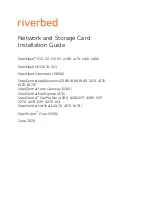
Chapter 13 Spanning Tree Protocol
MES3500 Series User’s Guide
126
Max Age
This is the maximum time (in seconds) a switch can wait without receiving a BPDU before
attempting to reconfigure. All switch ports (except for designated ports) should receive
BPDUs at regular intervals. Any port that ages out STP information (provided in the last
BPDU) becomes the designated port for the attached LAN. If it is a root port, a new root
port is selected from among the Switch ports attached to the network. The allowed range
is 6 to 40 seconds.
Forwarding Delay This is the maximum time (in seconds) a switch will wait before changing states. This
delay is required because every switch must receive information about topology changes
before it starts to forward frames. In addition, each port needs time to listen for
conflicting information that would make it return to a blocking state; otherwise,
temporary data loops might result. The allowed range is 4 to 30 seconds.
As a general rule:
Note: 2 * (Forward Delay - 1) >= Max Age >= 2 * (Hello Time + 1)
Port
This field displays the port number.
*
Settings in this row apply to all ports.
Use this row only if you want to make some settings the same for all ports. Use this row
first to set the common settings and then make adjustments on a port-by-port basis.
Note: Changes in this row are copied to all the ports as soon as you make them.
Active
Select this check box to activate STP on this port.
Edge
Select this check box to configure a port as an edge port when it is directly attached to a
computer. An edge port changes its initial STP port state from blocking state to forwarding
state immediately without going through listening and learning states right after the port
is configured as an edge port or when its link status changes.
Note: An edge port becomes a non-edge port as soon as it receives a Bridge Protocol Data
Unit (BPDU).
Root Guard
Select this check box to enable root guard on this port in order to prevent the switch(es)
attached to the port from becoming the root bridge.
With root guard enabled, a port is blocked when the Switch receives a superior BPDU on
it. The Switch allows traffic to pass through this port again when the switch connected to
the port stops to send superior BPDUs.
Priority
Configure the priority for each port here.
Priority decides which port should be disabled when more than one port forms a loop in
the Switch. Ports with a higher priority numeric value are disabled first. The allowed range
is between 0 and 255 and the default value is 128.
Path Cost
Path cost is the cost of transmitting a frame on to a LAN through that port. It is
recommended that you assign this value according to the speed of the bridge. The slower
the media, the higher the cost - see
for more information.
The default path cost value varies depending on the default path cost method you
selected.
Tree
Select which STP tree configuration this port should participate in.
Apply
Click
Apply
to save your changes to the Switch’s run-time memory. The Switch loses
these changes if it is turned off or loses power, so use the
Save
link on the top navigation
panel to save your changes to the non-volatile memory when you are done configuring.
Cancel
Click
Cancel
to begin configuring this screen afresh.
Table 34
Advanced Application > Spanning Tree Protocol > MRSTP (continued)
LABEL
DESCRIPTION
Содержание MES3500 Series
Страница 16: ...Table of Contents MES3500 Series User s Guide 16 Appendix C Legal Information 357 Index 362...
Страница 17: ...17 PART I User s Guide...
Страница 72: ...72 PART II Technical Reference...
Страница 106: ...Chapter 9 VLAN MES3500 Series User s Guide 106 Figure 49 Advanced Application VLAN Port Based VLAN Setup Port Isolation...
Страница 178: ...Chapter 22 Policy Rule MES3500 Series User s Guide 178 Figure 98 Policy Example EXAMPLE...
Страница 360: ...Appendix C Legal Information MES3500 Series User s Guide 360 Environmental Product Declaration...
















































